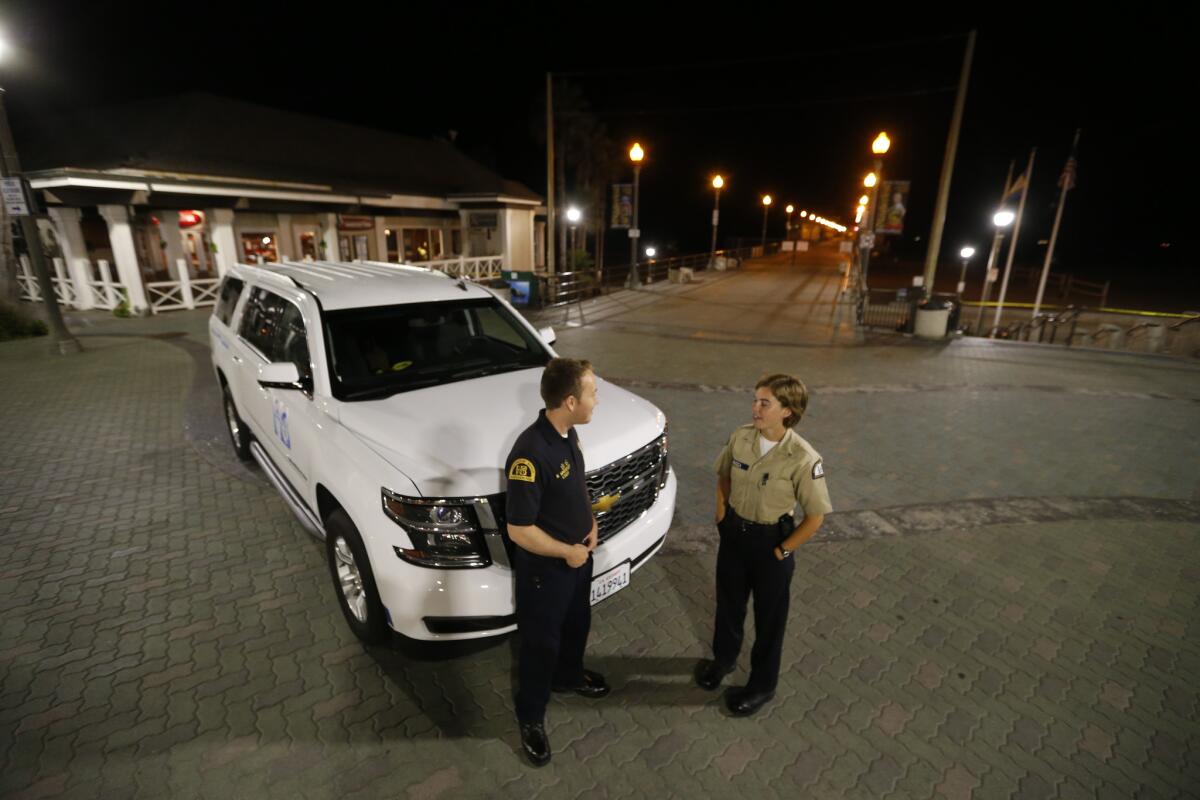Looks like the tsunami from Chile spared Southern California

Huntington Beach search and rescue explorers K. Raygoza and staff officer N. Wheatley supervise the closing of the Huntington Beach pier.
Tsunami surges from a huge earthquake in Chile hit the Southern California coast early Thursday, causing tide fluctuations of up to a foot, but there were no reports of damage or flooding.
The National Weather Service said several points along the coast were beginning to see tide fluctuations, which could continue for several hours.
Ventura County’s coastline saw a 13-inch surge, and the water off Santa Monica was lifted about 6 inches, the National Weather Service said.
In Seal Beach, the waves were projected to be as much as 0.8 feet. But as the sun peeked up at the pier, oil rig workers outfitted in bright orange life jackets charged underneath and over yellow caution tape that was supposed to block entrance to the pier.
“Ain’t no tsunami goin’ slow us down!” one worker yelled as he slid underneath the tape.
One of the safety workers who identified himself only by his first name — Riston — laughed when told that an advisory was issued for a 1-foot wave, and said his level of concern was “very low.”
“The structural integrity of the platforms are built to withstand earthquakes,” he said. “I think we’re in a big enough boat.”
See the most-read stories this hour >>
Tom and Robin Duszynski sipped their coffee as they watched the workers go by. The Seal Beach residents got the tsunami alert Wednesday night and figured they could check the waves while walking their dog Thursday morning.
“Nothing,” Robin, 54, said.
“If it’s heavy surf, you can usually hear it from here,” Tom added. “But you can barely hear anything now.”
Seal Beach is no stranger to wintertime big waves and high tides, which can flood nearby apartment buildings, homes and alleys, locals said. Those events usually draw media attention and create buzz in the small beach town.
During those crises, the waves slam into the pier and are audible from a great distance, Robin said.
Asked to describe her level of concern about Thursday’s possible tsunami, she said, “Zero.”
Another resident said it still could happen.
“Sometimes there’s a calm before the storm,” Ginny Ferguson, a 60-year-old local swim instructor said. “But it’s as quiet as I’ve ever seen it. It’s like a lake.”
At Middle Harbor at the Port of Long Beach, the water was calm.
Darin Denos, a 48-year-old Seal Beach resident, works as a manager for a tugboat service company that operates in the Port of Long Beach. Since he has “floating assets” in the water and a home near the beach, he said he has been monitoring the tsunami warning closely since Wednesday night.
He was even in touch with the mayor of Seal Beach and used binoculars to scope out the waters from his house. Denos said that any potential threat to the port and its cargo should be taken seriously because such threats can quickly become economically “catastrophic.”
Thursday morning he said he was “relieved” that the worst of the tsunami was over and “it’s not going to ... create carnage.”
“The people that are laughing are watching because they want to see something happen,” Denos said. “They poo-poo it, but if you think about that 1-foot swell and how far it traveled ... that’s a pretty significant force, if you ask me.
“It’s a real thing that people need to take seriously.”
Port of Los Angeles spokesman Phillip Sanfield said port employees were ready.
“We did overnight watches, made sure that there were no people on the waterline, informed terminal operators and marina residents,” Sanfield said. “Fortunately, it was a non-event this morning.”
A “widespread inundation of land is not expected” for the advisory areas, though forecasters expect strong currents and dangerous waves, and the ocean current could be especially hazardous for several hours, according to the weather service’s Tsunami Warning Center.
In recent years, powerful earthquakes have struck other parts of the Pacific Rim, generating tsunamis that have proved deadly once arriving in California.
A magnitude 8.8 earthquake rocked Chile on Feb. 27, 2010, with tsunami waves as high as 3 feet arriving in Santa Barbara and Santa Cruz, according to data compiled by the state Department of Conservation. Currents reached speeds of up to 15 knots, or about 17 mph, far above the 8-knot threshold needed for currents to damage piers and harbors.
The following year, on March 11, 2011, a tsunami set boats loose and damaged 20 docks in Ventura Harbor after a deadly earthquake hit off the northeastern coast of Japan. Shelter Island in San Diego also reported significant damage.
The tsunami brought 6- to 8-foot surges that flooded beaches and harbors, splintering docks, crushing scores of boats and triggering the evacuations of residents near the shore. One person died, and marinas and harbors up and down the coast saw extensive damage.
The waves from the Japanese earthquake were significantly larger than the ones expected to hit Southern California early Thursday.
ALSO:
8.3 quake hits off northern Chile; jolt sways buildings and kills 8
Greater tsunami risk from Southern California quake, study finds
L.A. officials present a plan for renters and landlords to split the costs of quake retrofitting
